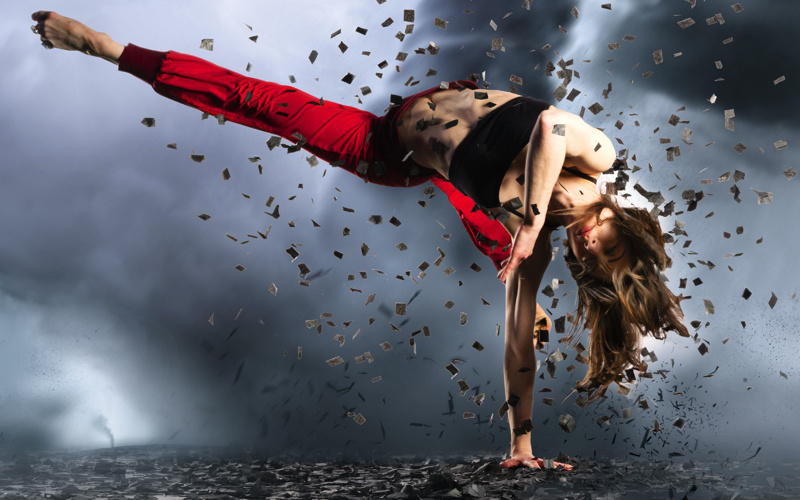
A storm of the mind as well as in temperament.
The piece opens with the dancers rooted to the floor, in what seems like the foundations of a tree. As tensions build, the tree begins to sway by the wind which causes a ripple through each performer. The storm builds taking hold of the dancers swirling them through the space like leaves drifting through the wind. Thus creating, an autumnal flurry of movement and immersive sound. It’s imagery like this, that forms the development of the storm throughout the piece. The dancers utilise this as well as breath to create the effect of the ever-growing storm around us. It’s their skill and power as performers that really drives the audience with them through the storm that’s created.
The movement used was often self-indulgent allowing us to see the performers not as performers but as people, with their own desires and limitations. Even when taken by the wind and shifted through the space, the performers remained as themselves, not characters. Their own emotions drove them to move and create, with the ensemble often echoing the soloists state of mind in the backdrop of the stage. At times, swirling and spiralling across the space whilst the soloists remained still, reflecting their inner turmoil although their own appearance remained static and unphased. The first half of the piece focuses on simpler values to portray the story of the storm, imagery via use of line and shape within the movement and allowing the knock-on effect from dancer to dancer which creates this ever-building tension.
However, the second half, relies heavily on theatrics and storytelling to get this point across. The timing of movements and the beginning of phrases becomes predictable, which with such fascinating, detailed music (composed by Amarok / Michal Wojtas which I shall be purchasing once released) becomes frustrating. There seems a loss of detail in the realness of these people, which was previously so enchanting. Facial expressions become forced and lose their authenticity, with an absence of realism in their hands and reaches.
Although, with this being said, the theatrical elements really did provide food for thought. Especially the initial solo by Norikazu Aoki. It approached the theme of mental health with self – destructiveness and the desire from those around him to help fight this addiction. These things are extremely important to be visualised in work on stage and such a difficult topic to explore well. By leaving the solo so simple, it allowed the audience to resolve their own interpretation of what was happening. It sparked a real understanding of these issues from the point of those witnessing someone deteriorate and how we can and should assist in those moments of self-harm. This sharing of help was continued throughout the piece with simple, gestural motifs such as that as the unfolding of hands.
The role of the observer stands as its own motif throughout the piece. This played by the choreographer James Wilton. He is present in almost all the scenes providing stillness to the continuing motion on stage. This leads me to question, is this piece the story of one man? Are the performers on stage sharing his own personal experiences to the audience? And was this his journey to self help and how he overcame his own demons?

